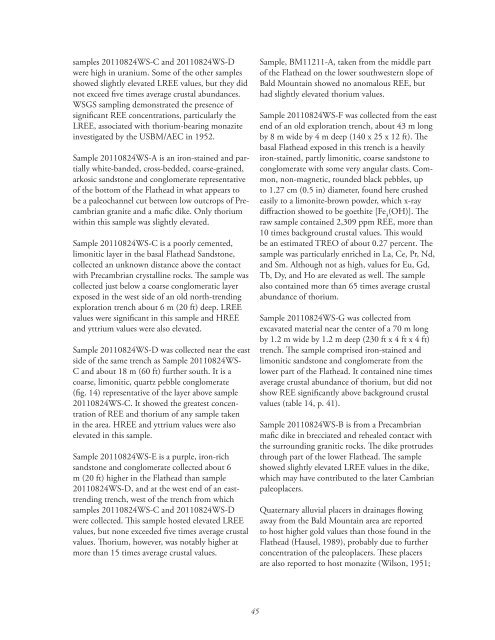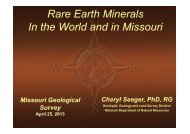You also want an ePaper? Increase the reach of your titles
YUMPU automatically turns print PDFs into web optimized ePapers that Google loves.
samples 20110824WS-C and 20110824WS-D<br />
were high <strong>in</strong> uranium. Some of the other samples<br />
showed slightly elevated LREE values, but they did<br />
not exceed five times average crustal abundances.<br />
WSGS sampl<strong>in</strong>g demonstrated the presence of<br />
significant REE concentrations, particularly the<br />
LREE, associated with thorium-bear<strong>in</strong>g monazite<br />
<strong>in</strong>vestigated by the USBM/AEC <strong>in</strong> 1952.<br />
Sample 20110824WS-A is an iron-sta<strong>in</strong>ed and partially<br />
white-banded, cross-bedded, coarse-gra<strong>in</strong>ed,<br />
arkosic sandstone and conglomerate representative<br />
of the bottom of the Flathead <strong>in</strong> what appears to<br />
be a paleochannel cut between low outcrops of Precambrian<br />
granite and a mafic dike. Only thorium<br />
with<strong>in</strong> this sample was slightly elevated.<br />
Sample 20110824WS-C is a poorly cemented,<br />
limonitic layer <strong>in</strong> the basal Flathead Sandstone,<br />
collected an unknown distance above the contact<br />
with Precambrian crystall<strong>in</strong>e rocks. The sample was<br />
collected just below a coarse conglomeratic layer<br />
exposed <strong>in</strong> the west side of an old north-trend<strong>in</strong>g<br />
exploration trench about 6 m (20 ft) deep. LREE<br />
values were significant <strong>in</strong> this sample and HREE<br />
and yttrium values were also elevated.<br />
Sample 20110824WS-D was collected near the east<br />
side of the same trench as Sample 20110824WS-<br />
C and about 18 m (60 ft) further south. It is a<br />
coarse, limonitic, quartz pebble conglomerate<br />
(fig. 14) representative of the layer above sample<br />
20110824WS-C. It showed the greatest concentration<br />
of REE and thorium of any sample taken<br />
<strong>in</strong> the area. HREE and yttrium values were also<br />
elevated <strong>in</strong> this sample.<br />
Sample 20110824WS-E is a purple, iron-rich<br />
sandstone and conglomerate collected about 6<br />
m (20 ft) higher <strong>in</strong> the Flathead than sample<br />
20110824WS-D, and at the west end of an easttrend<strong>in</strong>g<br />
trench, west of the trench from which<br />
samples 20110824WS-C and 20110824WS-D<br />
were collected. This sample hosted elevated LREE<br />
values, but none exceeded five times average crustal<br />
values. Thorium, however, was notably higher at<br />
more than 15 times average crustal values.<br />
45<br />
Sample, BM11211-A, taken from the middle part<br />
of the Flathead on the lower southwestern slope of<br />
Bald Mounta<strong>in</strong> showed no anomalous REE, but<br />
had slightly elevated thorium values.<br />
Sample 20110824WS-F was collected from the east<br />
end of an old exploration trench, about 43 m long<br />
by 8 m wide by 4 m deep (140 x 25 x 12 ft). The<br />
basal Flathead exposed <strong>in</strong> this trench is a heavily<br />
iron-sta<strong>in</strong>ed, partly limonitic, coarse sandstone to<br />
conglomerate with some very angular clasts. Common,<br />
non-magnetic, rounded black pebbles, up<br />
to 1.27 cm (0.5 <strong>in</strong>) diameter, found here crushed<br />
easily to a limonite-brown powder, which x-ray<br />
diffraction showed to be goethite [Fe 3 (OH)]. The<br />
raw sample conta<strong>in</strong>ed 2,309 ppm REE, more than<br />
10 times background crustal values. This would<br />
be an estimated TREO of about 0.27 percent. The<br />
sample was particularly enriched <strong>in</strong> La, Ce, Pr, Nd,<br />
and Sm. Although not as high, values for Eu, Gd,<br />
Tb, Dy, and Ho are elevated as well. The sample<br />
also conta<strong>in</strong>ed more than 65 times average crustal<br />
abundance of thorium.<br />
Sample 20110824WS-G was collected from<br />
excavated material near the center of a 70 m long<br />
by 1.2 m wide by 1.2 m deep (230 ft x 4 ft x 4 ft)<br />
trench. The sample comprised iron-sta<strong>in</strong>ed and<br />
limonitic sandstone and conglomerate from the<br />
lower part of the Flathead. It conta<strong>in</strong>ed n<strong>in</strong>e times<br />
average crustal abundance of thorium, but did not<br />
show REE significantly above background crustal<br />
values (table 14, p. 41).<br />
Sample 20110824WS-B is from a Precambrian<br />
mafic dike <strong>in</strong> brecciated and rehealed contact with<br />
the surround<strong>in</strong>g granitic rocks. The dike protrudes<br />
through part of the lower Flathead. The sample<br />
showed slightly elevated LREE values <strong>in</strong> the dike,<br />
which may have contributed to the later Cambrian<br />
paleoplacers.<br />
Quaternary alluvial placers <strong>in</strong> dra<strong>in</strong>ages flow<strong>in</strong>g<br />
away from the Bald Mounta<strong>in</strong> area are reported<br />
to host higher gold values than those found <strong>in</strong> the<br />
Flathead (Hausel, 1989), probably due to further<br />
concentration of the paleoplacers. These placers<br />
are also reported to host monazite (Wilson, 1951;



